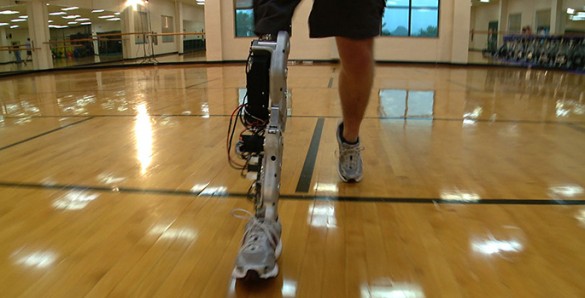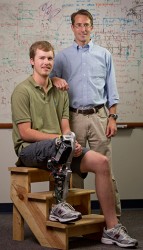
The tragic April 15 bombing at the Boston Marathon took the lives of three people and has left dozens of people with serious injuries, many of whom have lost limbs.
Vanderbilt mechanical engineer Michael Goldfarb, an expert in the field of prosthetic devices and director of the Center for Intelligent Mechatronics, says dramatic advances in technology could help give these victims artificial legs that work much better than ever before.
“Within the next one to three years, ‘bionic’ prosthetic devices will be available for people that are substantially smarter, more capable, more active and more interactive than those that are currently on the market,” said Goldfarb, the H. Fort Flowers Professor of Mechanical Engineering at Vanderbilt.
Bionic Leg
In the last few years Goldfarb and his colleagues have developed the first bionic lower limb prosthetic with powered knee and ankle joints that operate in unison. It is the type of prosthetic that many of the Boston victims with severe leg injuries will need because most had their legs amputated above the knee.
This bionic leg comes equipped with sensors that monitor its user’s motion. It has microprocessors programmed to use this data to “sense” and predict what the person is trying to do and operate the device in ways that facilitate these movements.
“The kinds of devices that we are developing make it possible for users to perform a number of ‘patterned’ activities, such as sitting, standing, walking on an incline, or walking up and down stairs,” Goldfarb said. “And it helps patients to walk with a more comfortable and smooth gait. But they are not yet suitable for ‘unpatterned activities’ like dancing.”
A Thousand Steps in the Bionic Leg

Last November, researchers at the Rehabilitation Institute of Chicago modified one of Goldfarb’s bionic prosthetic limbs with a simple neural interface. The combination allowed amputee Zac Vawter to set a record by climbing 103 flights of stairs to the top of Chicago’s Willis Towers.
But Goldfarb says engineers need more time to perfect the device for all users.
“There is a big difference between designing a neural system in a lab that will work with one person and developing a system suitable for a mass market,” said Goldfarb.
Prosthetics and Smartphones
Goldfarb sees a parallel between the progress currently being made in prosthetic device technology and the evolution of the cell phone into the smartphone.
“Smartphones are a lot more complicated than cell phones and they can to a lot more things. However, they have managed to maintain the same basic level of reliability,” he said. “The neural interface is similar to the Siri voice recognition system— if it is done well, it will make a tremendous difference. But if it doesn’t work well, we can still make use of most of the functionality of our devices without it.”
Contact:
David Salisbury, (615) 322-NEWS
david.salisbury@vanderbilt.edu
